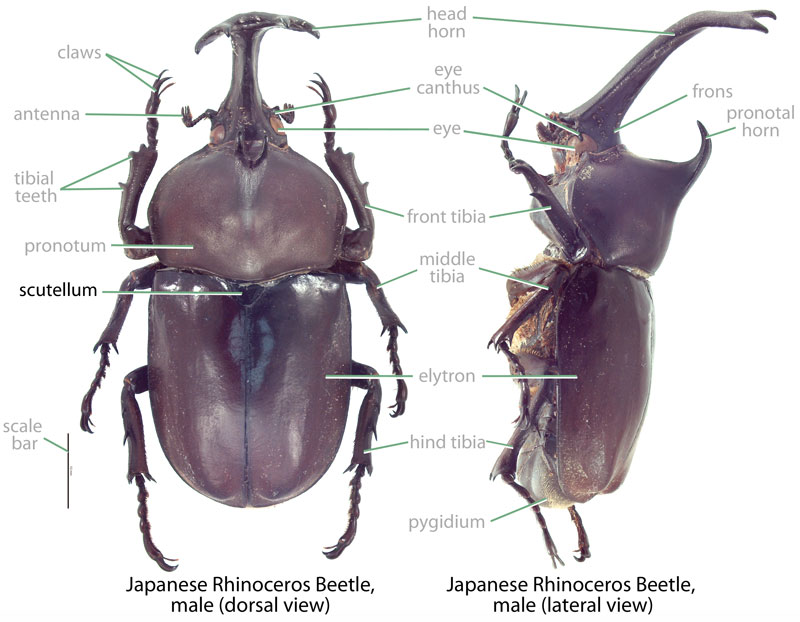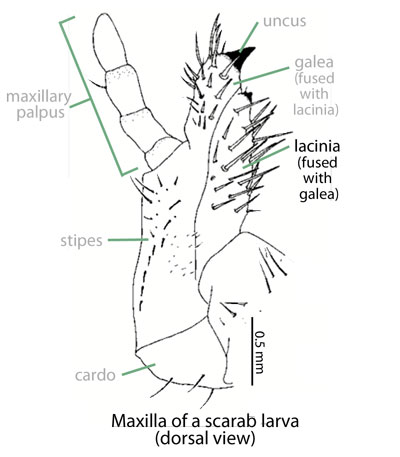Beneficial
none known
Family: Scarabaeidae Subfamily: Scarabaeinae Genus: Onthophagus Species: Onthophagus armatus Blanchard, 1853
none available
Total body length 6.0–10.0 mm (0.24–0.39 in). Body shape oval; may be caked in dung. Color shiny black. Small or medium-sized Onthophagus, over 6 mm. Clypealclypeal:
of, or referring to, the clypeus
apexapex:
point or edge furthest from the body
of major male bisinuatebisinuate:
possessing two sinuate edges or portions, with two curves
, not strongly reflexedreflexed:
margin that curves upward
; minor male and female with clypealclypeal:
of, or referring to, the clypeus
apexapex:
point or edge furthest from the body
rounded to feebly sinuatesinuate:
gently curved (specifically of margins or edges); often in reference to the clypeus
. Head of major male with 2 sinuatesinuate:
gently curved (specifically of margins or edges); often in reference to the clypeus
, vertically oriented horns, that are connected by a broad ridge; female and minor male with feebly sinuatesinuate:
gently curved (specifically of margins or edges); often in reference to the clypeus
ridge near base. Ocular canthuscanthus:
a process extending over and sometimes dividing the eye
not completely dividing eye. Pronotumpronotum:
the dorsal surface of the thorax
 of male with hump-like process; female lacking process. Pronotumpronotum:
of male with hump-like process; female lacking process. Pronotumpronotum:
the dorsal surface of the thorax
 with anterioranterior:
with anterioranterior:
the front or forward; opposite of posterior
angles rounded. Front tibiatibia:
a segment of the leg articulated with the tarsus and femur
 of male slightly slender and elongate, female tibiatibia:
of male slightly slender and elongate, female tibiatibia:
a segment of the leg articulated with the tarsus and femur
 comparatively stout. Scutellumscutellum:
comparatively stout. Scutellumscutellum:
the triangular portion of the thorax between the bases of the elytra
 absent.
absent.
Undescribed. For Onthophagus spp. (Ritcher, 1966Ritcher, 1966:
Ritcher P. 1966. White grubs and their allies: a study of North American scarabaeoid larvae. Oregon State University Monographs, Studies in Entomology 4: 1-219.): Grub C-shaped, hump-backed, cylindrical, and cream-colored. Maxillamaxilla:
set of paired mouthparts located posterior to the mandibles
with galeagalea:
outer branch or lobe of the maxilla
 and lacinialacinia:
and lacinialacinia:
inner portion of the maxilla distinctly separate. Epipharynxepipharynx:
distinctly separate. Epipharynxepipharynx:
lobe on the interior surface of the labrum or clypeus
with tormaetormae:
in scarab larvae, sclerotized structures on the ends of the clypeolateral suture extending towards the mesal line
united mesallymesally:
at or near midline of body
, anterioranterior:
the front or forward; opposite of posterior
phoba present. AntennaeAntennae:
paired sensory organ on head, formed from numerous segments
 4-segmented, distaldistal:
4-segmented, distaldistal:
situated away from the point of articulation, thus usually furthest from the body
segment much reduced. Legs 2-segmented. Prothoracic shieldprothoracic shield:
the chitinous plate behind the head of larvae
 without anteriorly projecting processes. Third abdominal segment bearing a prominent conical, dorsaldorsal:
without anteriorly projecting processes. Third abdominal segment bearing a prominent conical, dorsaldorsal:
of or relating to the upper surface; opposite of ventral
gibbosity covered with numerous short, stout setaesetae:
small, hair-like structure
.
Eastern Asia. This species is recorded from much of eastern Asia including India, Burma (Myanmar), Taiwan (Chandra and Gupta, 2013Chandra and Gupta, 2013:
Chandra K and Gupta D. 2013. Taxonomic studies on dung beetles (Coleoptera: Scarabaeidae, Geotrupidae, Hybosoridae) of Chhattisgarh, India. Munis Entomology amp; Zoology 8: 331-360. full text (accessed 2015)), Indochina, Malaysia, Indonesia, and the Philippines (Cartwright and Gordon, 1971Cartwright and Gordon, 1971:
Cartwright O and Gordon R. 1971. Insects of Micronesia Coleoptera: Scarabaeidae. Insects of Micronesia 17: 256-296.).
None. This species feeds on dung as both an adult and larvalarva:
the immature form of an insect; in scarabs, also called grub or white grub; preceded by the egg stage, followed by the pupal stage
 . There are no records of this beetle feeding on live plant tissues.
. There are no records of this beetle feeding on live plant tissues.
Poorly known: Adults of this nocturnal species are dung tunnelers (Chandra and Gupta, 2013Chandra and Gupta, 2013:
Chandra K and Gupta D. 2013. Taxonomic studies on dung beetles (Coleoptera: Scarabaeidae, Geotrupidae, Hybosoridae) of Chhattisgarh, India. Munis Entomology amp; Zoology 8: 331-360. full text (accessed 2015)). Females locate dung and create a burrow near or under a dung source. The burrow is provisioned with dung that is formed into brood balls. An egg is deposited within each brood ball, and larval development occurs within.
None. This species recycles dung and is beneficial for ranching and farming in Hawaii. Primarily being a dung feeder, this species has never been recorded damaging crop or ornamental plants. Additionally, this species is not a threat to native dung beetles because none occur in Hawaii or Guam.
Not established or recorded. There are no records of this species from Hawaii.
Established. This species is established on Guam (Bourquin, 2002Bourquin, 2002:
Bourquin O. 2002. Invertebrates recorded from the Northern Mariana Islands status 2002. CNMI Invertebrate Collection Crees-Northern Marianas College, Saipan.). Based on in-field observations and specimens examined at the University of Guam, this species is common on the island.
It is unclear when or how this scarab first arrived to Guam, although Cartwright and Gordon (1971) proposed that it may have arrived from the Philippines. It is possible that the species arrived on military ships or aircraft during or after World War 2, though this is speculation.
This scarab could be confused with similar small to medium-sized Onthophagus (more than 6 mm) including Onthophagus binodis, Onthophagus incensus, Onthophagus comperei, Onthophagus cuniculus and Onthophagus laminatus.
Major males of these species can readily be distinguished by examining the head armature (O. armatus with vertical, bisinuatebisinuate:
possessing two sinuate edges or portions, with two curves
horns versus O. cuniculus with pairedpaired:
in relation to bilateral symmetry: occurring on both sides of the body
tubercles, O. binodislacking horns or tubercles, O. comperei with sinuatesinuate:
gently curved (specifically of margins or edges); often in reference to the clypeus
, vertically-oriented, weakly bifurcatebifurcate:
a process dividing into two points
horns, O. incensus and O. laminatusboth with slightly curved, vertically-oriented, undivided horns).
Females are separated by examining the base of the head (O. armatus with feebly bisinuatebisinuate:
possessing two sinuate edges or portions, with two curves
ridge versus O. laminatus and O. incensus with a straight, transversetransverse:
extending horizontally across a surface
ridge, O. compereiwith 2 tubercles, O. binodis and O. cuniculus with a slightly curved ridge), pronotumpronotum:
the dorsal surface of the thorax
 (O. armatus lacking process versus O. binodis with small lobe-like process, O. cuniculus with bi-lobedbi-lobed:
(O. armatus lacking process versus O. binodis with small lobe-like process, O. cuniculus with bi-lobedbi-lobed:
possessed of two lobe-like structures
process) and anterioranterior:
the front or forward; opposite of posterior
pronotal angle (O. armatus with anterioranterior:
the front or forward; opposite of posterior
angle rounded versus O. cuniculusand O. laminatus with anterioranterior:
the front or forward; opposite of posterior
angle curved outward).
Onthophagus luzonicus Lansberge
Report your observation of this beneficial species at our iNaturalist project.